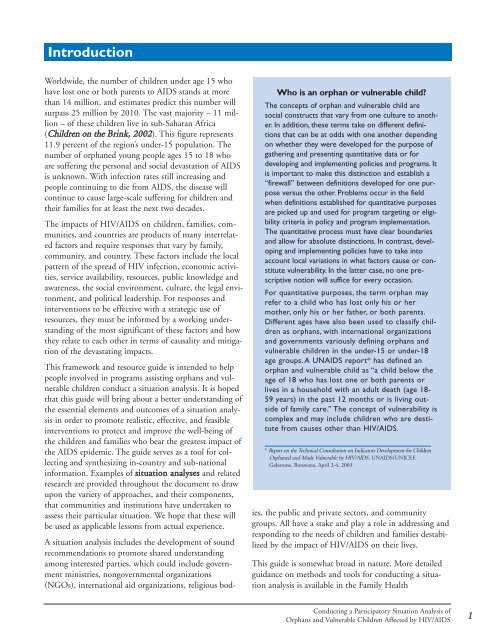Conducting a Participatory Situation Analysis of.pdf - Global HIV ...
Conducting a Participatory Situation Analysis of.pdf - Global HIV ...
Conducting a Participatory Situation Analysis of.pdf - Global HIV ...
Create successful ePaper yourself
Turn your PDF publications into a flip-book with our unique Google optimized e-Paper software.
Introduction<br />
Worldwide, the number <strong>of</strong> children under age 15 who<br />
have lost one or both parents to AIDS stands at more<br />
than 14 million, and estimates predict this number will<br />
surpass 25 million by 2010. The vast majority – 11 million<br />
– <strong>of</strong> these children live in sub-Saharan Africa<br />
(Children on the Brink, 2002). This figure represents<br />
11.9 percent <strong>of</strong> the region’s under-15 population. The<br />
number <strong>of</strong> orphaned young people ages 15 to 18 who<br />
are suffering the personal and social devastation <strong>of</strong> AIDS<br />
is unknown. With infection rates still increasing and<br />
people continuing to die from AIDS, the disease will<br />
continue to cause large-scale suffering for children and<br />
their families for at least the next two decades.<br />
The impacts <strong>of</strong> <strong>HIV</strong>/AIDS on children, families, communities,<br />
and countries are products <strong>of</strong> many interrelated<br />
factors and require responses that vary by family,<br />
community, and country. These factors include the local<br />
pattern <strong>of</strong> the spread <strong>of</strong> <strong>HIV</strong> infection, economic activities,<br />
service availability, resources, public knowledge and<br />
awareness, the social environment, culture, the legal environment,<br />
and political leadership. For responses and<br />
interventions to be effective with a strategic use <strong>of</strong><br />
resources, they must be informed by a working understanding<br />
<strong>of</strong> the most significant <strong>of</strong> these factors and how<br />
they relate to each other in terms <strong>of</strong> causality and mitigation<br />
<strong>of</strong> the devastating impacts.<br />
This framework and resource guide is intended to help<br />
people involved in programs assisting orphans and vulnerable<br />
children conduct a situation analysis. It is hoped<br />
that this guide will bring about a better understanding <strong>of</strong><br />
the essential elements and outcomes <strong>of</strong> a situation analysis<br />
in order to promote realistic, effective, and feasible<br />
interventions to protect and improve the well-being <strong>of</strong><br />
the children and families who bear the greatest impact <strong>of</strong><br />
the AIDS epidemic. The guide serves as a tool for collecting<br />
and synthesizing in-country and sub-national<br />
information. Examples <strong>of</strong> situation analyses and related<br />
research are provided throughout the document to draw<br />
upon the variety <strong>of</strong> approaches, and their components,<br />
that communities and institutions have undertaken to<br />
assess their particular situation. We hope that these will<br />
be used as applicable lessons from actual experience.<br />
Who is an orphan or vulnerable child?<br />
The concepts <strong>of</strong> orphan and vulnerable child are<br />
social constructs that vary from one culture to another.<br />
In addition, these terms take on different definitions<br />
that can be at odds with one another depending<br />
on whether they were developed for the purpose <strong>of</strong><br />
gathering and presenting quantitative data or for<br />
developing and implementing policies and programs. It<br />
is important to make this distinction and establish a<br />
“firewall” between definitions developed for one purpose<br />
versus the other. Problems occur in the field<br />
when definitions established for quantitative purposes<br />
are picked up and used for program targeting or eligibility<br />
criteria in policy and program implementation.<br />
The quantitative process must have clear boundaries<br />
and allow for absolute distinctions. In contrast, developing<br />
and implementing policies have to take into<br />
account local variations in what factors cause or constitute<br />
vulnerability. In the latter case, no one prescriptive<br />
notion will suffice for every occasion.<br />
For quantitative purposes, the term orphan may<br />
refer to a child who has lost only his or her<br />
mother, only his or her father, or both parents.<br />
Different ages have also been used to classify children<br />
as orphans, with international organizations<br />
and governments variously defining orphans and<br />
vulnerable children in the under-15 or under-18<br />
age groups. A UNAIDS report* has defined an<br />
orphan and vulnerable child as “a child below the<br />
age <strong>of</strong> 18 who has lost one or both parents or<br />
lives in a household with an adult death (age 18-<br />
59 years) in the past 12 months or is living outside<br />
<strong>of</strong> family care.” The concept <strong>of</strong> vulnerability is<br />
complex and may include children who are destitute<br />
from causes other than <strong>HIV</strong>/AIDS.<br />
* Report on the Technical Consultation on Indicators Development for Children<br />
Orphaned and Made Vulnerable by <strong>HIV</strong>/AIDS. UNAIDS/UNICEF.<br />
Gaborone, Botswana. April 2-4, 2003<br />
A situation analysis includes the development <strong>of</strong> sound<br />
recommendations to promote shared understanding<br />
among interested parties, which could include government<br />
ministries, nongovernmental organizations<br />
(NGOs), international aid organizations, religious bodies,<br />
the public and private sectors, and community<br />
groups. All have a stake and play a role in addressing and<br />
responding to the needs <strong>of</strong> children and families destabilized<br />
by the impact <strong>of</strong> <strong>HIV</strong>/AIDS on their lives.<br />
This guide is somewhat broad in nature. More detailed<br />
guidance on methods and tools for conducting a situation<br />
analysis is available in the Family Health<br />
<strong>Conducting</strong> a <strong>Participatory</strong> <strong>Situation</strong> <strong>Analysis</strong> <strong>of</strong><br />
Orphans and Vulnerable Children Affected by <strong>HIV</strong>/AIDS<br />
1















